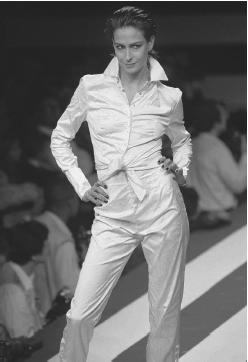Popy Moreni - Fashion Designer Encyclopedia
French designer
Born: Annalisa Moreni in Turin, Italy, 3 December 1947. Education: Istituto Statale d'Arte, Moda e Costume, Turin, 1961-64. Family: Children: Amour, Aimée. Career: Moved to Paris, 1964; design assistant to Maïmé Arnaudin, 1964; designer in Arnaudin's Mafia design studio, Paris, 1965-67, and in Promostyl, Paris, 1967-73; designer, Timmi, 1972; established own design and consulting office (working for Rhone-Poulenc Textile and Rasurel), from 1973; first boutique opened, Paris, 1976; first fashion collection, 1980; first creations for Swiss catalogues, 1981; ready-to-wear licensed, from 1982; childrenswear licensed, from 1987; introduced housewares,

Publications
On MORENI:
Books
Deslandres, Yvonne, Histoire de la mode au XXme siécle, Paris, 1986.
Benaim, Laurence, L'Année de la mode, Paris, 1988.
Articles
Godard, Colette, "La mode comme le souvenir d'un bonheur," in Le Monde (Paris), April 1986.
Seraglini, Marie, "Carte noire et blanche á Popy Moreni," in Maison Française (Paris), July 1986.
Perrier, M.J., "Designer Close Up," in Interior (London), March 1987.
Mont Servan, N., "Les 100 poids lourds de la mode," in Passion (Paris), February 1990.
Born, Pete, "Scent Spout Wide Open," in WWD, 11 October 1996.
"Martin Gras: A Master Perfumer at Work," in Soap & Cosmetics, January 1999.
"Popy Moreni," available online at Fashion Windows, www.fashionwindows.com , March 2001.
*
I hope to love everything, unfortunately I cannot yet do so. In fact, I tell myself that what I do not love is simply what I do not understand. So, potentially, I love everything: the real and the false, the authentic and the copied, the straight line and the curve, elegance and vulgarity, the good and the bad, the law-abiding and the outlaw. I would like to do everything! Not necessarily in order to do but in order to search…. I'm rather inquisitive and dissatisfied on the whole…so I persevere! I am active because the unknown is so potent…
For my work I like silence, white and black, open countryside, concrete, the morning, thick pencils…the ideas are in the pencil…. It is through drawing a lot that one makes discoveries…. You rarely get surprising results early on…
Work keeps me busy and prevents me asking myself too many questions. I am short of time to do everything I would like to…. So it is just a matter of choice and chance…
—Popy Moreni
***
Popy Moreni is an Italian designer working in Paris who has managed to combine distinctive style elements from both countries— a strong Italian sense of color and coordination, with a chic French practicality. She was born into an artistic family in Turin, Italy; her mother was a sculptor and her father a painter. She studied costume and design in Italy at L'Istituto Statale d'Arte, Moda e Costume, then moved to Paris at 17 to pursue a career in fashion. Her first job was at Mafia, the design studio of Maïmé Arnaudin; next she worked for the Promostyl Organization and the Italian firm Timmi until 1972.
She opened her own design studio in 1973 and worked on consultancies with a range of clients that included Rhone-Poulenc Textile and Rasurel. In 1980 she showed her first collection on the catwalk. She quickly became known for her witty, carefree clothes. A taste for theatricality and the baroque gave her collections the recurrent theme of commedia dell'arte with harlequin prints and jagged-cut details, satin capes and Pierrot collars, all translated into inventive sportswear shapes. She has also been inspired from her artistic heritage, looking to abstract painters like Jackson Pollock and Hans Hartung when designing and choosing prints.
By 1985 the collections had grown in size and breadth, incorporating such details as petal shapes, corollas, and plush velvets. More recent innovations were oversize crisp white cotton shirts decorated with ruffled cuffs and necklines. Cheeky sleeveless striped suits again

Expansion of the Moreni business began with the opening of her first boutique in the Les Halles district of Paris in 1976. In 1980 she began a joint collaboration with a French mail order firm, Les Trois Suisses, to design children's and women's clothes. She also developed a distinctive eveningwear line, as well as hat, shoe, and jewelry ranges. Of particular interest were her plastic shoes dyed to bright colors. A licensing agreement with Mitsukoshi Ltd. in Japan gave Moreni a lucrative Asian exposure and marketing of her name and products.
By the turn of the century Moreni continued to expand her business, introducing a wide range of products from housewares, linens, furniture, and rugs. Additionally, the third Moreni fragrance, Cirque, was launched in 2000.
—Kevin Almond
Comment about this article, ask questions, or add new information about this topic: